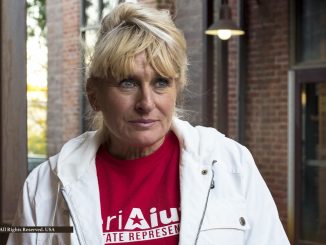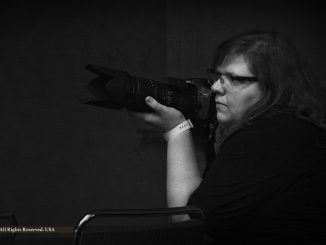
By all accounts, the 2018 mid-term elections were anything but typical. [1,2]
One of the established givens is that 95% of all incumbents are re-elected. And yet, right here in Michigan, US Senator Debbie Stabenow defeated her Republican opponent, John James, by her smallest margin ever. It’s the sort of stuff that made covering this cycle a very different sort of work in the end as opposed to when it started. [3,4,5,6]
To better understand this from the ground, Saline Journal asked John James for Senate campaign photographer Michaela Klusman about her experience here in Michigan.
Saline Journal: “When did your involvement begin and how did that change over time?”
Michaela Klusman: “I work a full-time job in marketing outside of any political work I do, so I can’t always do both once things get going.
With that said, the campaign cycle began slowly, with events here and there throughout the winter, spring, and summer. However, as we came into September, things really began to ramp up. By October, I was having to take days off of work to attend events and was working in different cities, most of which were at least an hour from my home. In the last week or two before the election, I had at least one event every evening and was having to pick and choose which to attend when I couldn’t make it from one to another.
Saline Journal: “In an era of social updating, what’s the right balance between working as a photographer who strives to ‘disappear into the background’ and inserting yourself into the story to build your own ‘personal brand’?”
Michaela Klusman: “I don’t think this question can be consistently answered. Each scenario, group, and event demands a slightly different etiquette just as they do photographic aesthetic. It is up to the discretion of the photographer to know when to insert oneself and when to stand back and observe and capture what is going on before you.
However, some of the greatest shots I have gotten were when I took a risk, moved forward, engaged with someone, and decided that the moment was worth inserting myself into. In order to adequately capture emotion and atmosphere, you have to achieve a balance that is quite delicate.
Saline Journal: “Working literally shoulder-to-shoulder with other reporters, how do you explain the often vast differences in the way the exact same content is covered by different outlets?”
Michaela Klusman: “One of the most interesting things I witnessed along that vein was the expressions that different outlets captured and then used.
For example, if I was shooting an event and the overall tone was excited and positive, I would use a photograph of a speaker or the room that I felt best encapsulated that feeling. Likewise, if the room were angry or determined, I would attempt to find a photo that represents that. However, as I watched various news outlets’ renditions of events that I had attended, they often used photographs of speakers that were caught mid-sentence during a decisive line and in which the speaker looked angry or even irate. This went along with an article that captured one minute detail from the event and expanded it be a depiction of the entire evening. Often they also used photos of the crowd at a point in their cheers that made them look raucous or unruly.
These tactics were powerful and do much to establish and perpetuate a certain narrative for all those not in attendance at the events. Now, don’t get me wrong. This was certainly not the case with every outlet or reporter. Many of them were fair-minded and dedicated to integrity as they cover an event and the campaign cycle as a whole.
Saline Journal: “Should there be a difference in standard for objectivity between ‘independent media’ and photographers connected to candidates, parties?”
Michaela Klusman: “Only insofar as a campaign-sponsored photographer is obviously there to support the campaign and candidate.
I don’t believe that either should misrepresent or misinform the public. In reality, if as a candidate photographer you feel the need to misrepresent reality about your candidate, you likely shouldn’t be supporting such a candidate as you clearly do not stand for their ideals.
However, the lack of objectivity in the media today is startling at best. It is a tragedy in our great nation and for our tremendous liberties that the very ‘independent media’ that is commissioned to courageously and discerningly inform the public has in great numbers stepped away and become exceedingly partisan and conniving.
As I previously mentioned, there are numerous honest and decent men and women that still work hard to deliver fair, balanced, and meaningful news to the citizens of their communities. For the others, I believe a revisit to the Journalist’s Creed may be in order. [7]
Saline Journal: “How do you responsibly balance ‘access’ against obligation to report on the discovered truths?”
Michaela Klusman: “For me it is usually simple. A candidate is first of all a human being and therefore they deserve the fundamental dignity and respect in their intimate moments with family or personally shared information that I would warrant any other person.
If in a private moment, a candidate discloses such information that would expose a threat to the Constitution, the nation, the state, or the community if they are elected or if they are not confronted, I believe it becomes the duty of a journalist to address it. If a journalist lacks that professional and personal discretion, I do not believe they have any business being in the field.”
Saline Journal: “Why should a political campaign enlist its own professional photographers when smartphone cameras and equipment technologies would appear to make this something that ‘anyone can do well’?”
Michaela Klusman: “Smartphone cameras are pretty remarkable! However, the capabilities of a smartphone camera and the types of images it can produce in comparison with an SLR are still vastly different. Additionally, the camera itself is much less powerful than the eye in the viewfinder and the unique vision of the photographer him- or herself.
If you want images that move people and capture the atmosphere in a moment or a place, you must find a true journalist.
References
- “Final 2018 Season Washtenaw Economic Club Luncheon Sought To Explain Impact Of November 6 Mid-Term Election Results” Dell Deaton (November 9, 2018) Saline Journal.
- “Washtenaw County Clerk Says There Is ‘Absolutely’ No Reason To Worry About 2018 Election Result Integrity In Michigan” Dell Deaton (November 4, 2018) Saline Journal.
- “Congressional elections” Khan Academy.
- “Exclusive Interview With Debbie Stabenow, Democratic Party Candidate For The United States Senate From Michigan” Dell Deaton (November 2, 2018) Saline Journal.
- “Exclusive Interview With John James, Republican Party Candidate For The United States Senate From Michigan” Dell Deaton (November 1, 2018) Saline Journal.
- “Stabenow defeats James in Michigan’s US Senate race” Leonard N Fleming (November 7, 2018) The Detroit News.
- “The Journalist’s Creed” Walter Williams, Missouri School of Journalism.



